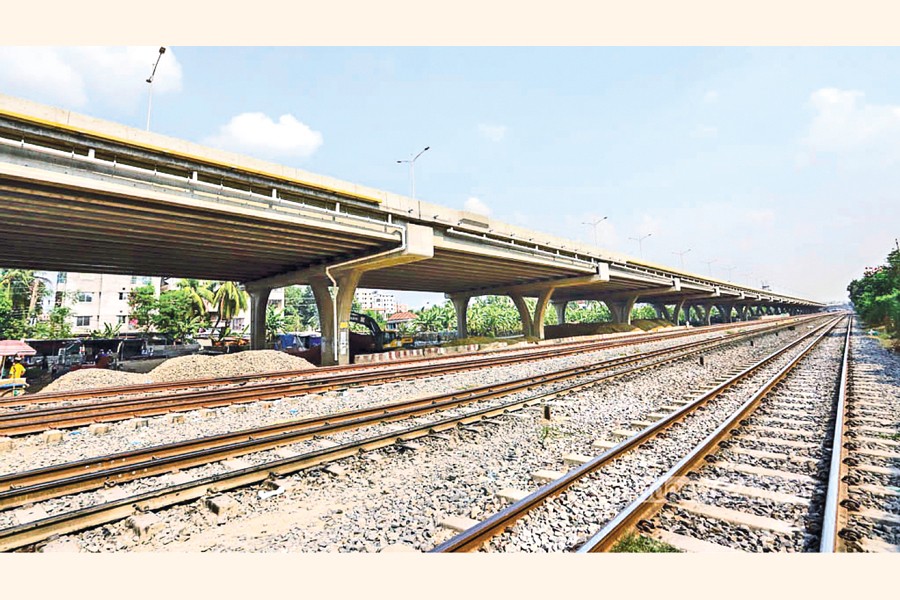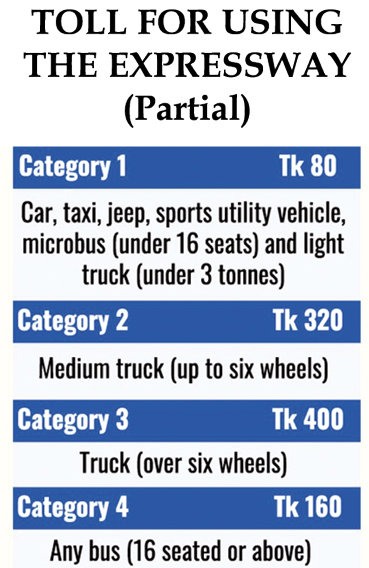 The photo shows Khilkhet-Airport stretch of the Dhaka Elevated Expressway — bdnews24.com Photo
The photo shows Khilkhet-Airport stretch of the Dhaka Elevated Expressway — bdnews24.com Photo -inset.jpg) FE: Why ITD has been interested in the PPP project in Bangladesh? The FE came to know DEE is ITD's first PPP project to start with although its success stories in infrastructure development as contractor were quite impressive. Why Bangladesh has been chosen as its first venture in the PPP?
FE: Why ITD has been interested in the PPP project in Bangladesh? The FE came to know DEE is ITD's first PPP project to start with although its success stories in infrastructure development as contractor were quite impressive. Why Bangladesh has been chosen as its first venture in the PPP?
MD: The scheme of the PPP first came from IFC, World Bank, ADB-like financiers during 2009 and 2010. Because it is huge amount of money for a government to build big infrastructures like ports, airports, roads and bridges. So PPP model helps get the funds from private investors who get interest after any government can make PPP projects financially viable. Like the ITD case in the DEE, the government's vulnerable gap funding (VGF) has ensured our investment to be viable and manage the tolls for earning revenue for a 25-year concessional period to repay the company loan.
We have many successful projects in different countries, including Rupsha bridge construction in Bangladesh. We know ITD can do more projects in Bangladesh. But the DEE is the first investment in PPP being convinced from the new concept initiated at that time by the financial institutions. Because they see the benefit getting the best investment without spending huge funds by the government. The country was chosen considering its population and traffic generation amid lack of adequate land. We find the opportunity of expressway on north-south corridor evaluating the fact of increased trend of traffic with the country's economic growth. From 2009 to 2023, per-capita GDP, middle- income group, I believe, increase three per cent a year. We see the development and feel the need for infrastructure investment In Bangladesh to move forward the company's reputation.
FE: Though sounds good, what we see later on is that ITD has to face various challenges in taking forward the DEE project in PPP model. How it is evaluated as an investor? It is also true that the DEE is Bangladesh's first big infrastructure project under PPP.
MD: it has to be understood that this PPP project started with nothing. Without challenges no big project gets successes. I thank all stakeholders for cooperating with us, particularly the vision of the Prime Minister to include DEE as election pledge. Yes, there were many challenges come in the DEE project like other projects. In all cases, you have to be flexible all the time. We have to wait long to redesign the alignment, manage funds, settle conflicts with other projects like metro rail which came later than the DEE. We believe solution always comes if all stakeholders look into any problem in open mind and ask what objectives we want to achieve. If they sit to find the objectives and discuss, the problem can be solved. We were always positive in finding solution to all crises.
FE: It is also true during all these years, situation like giving up the project from the government side as well as suggestion from experts to ITD to stop it. The ITD had also to wait long seven to eight years to find financiers for being unable to present the project as bankable.
 MD: In the beginning, we talked with the IFC for project finance. But, following the crisis centering the Padma Bridge, ITD has to restart the process. All -- WB, ADB and IFC--at the time had negative view in funding Bangladesh even though the PPP was initiated by them at that time. So ITD started looking in the financial market of China as an alternative. It was around 2015 and 2016 we look into the Chinese financial market for fund and managed the two Chinese companies within few years.
MD: In the beginning, we talked with the IFC for project finance. But, following the crisis centering the Padma Bridge, ITD has to restart the process. All -- WB, ADB and IFC--at the time had negative view in funding Bangladesh even though the PPP was initiated by them at that time. So ITD started looking in the financial market of China as an alternative. It was around 2015 and 2016 we look into the Chinese financial market for fund and managed the two Chinese companies within few years.
But the question is why did not we stop or give up? We did not find any reason to stop. We believe we can do lots of business here, and there are good opportunities. Problems will always come in, if we look into it and analyse it with stakeholders, in the end solution also comes out.
FE: It is hard that the DEE alignment over Dhaka city was prescribed by the investors. Do not you think it was a major reason for facing so many problems in smooth implementation of the project? Its design on entire corridor could not even be confirmed.
MD: What's the point if the congested city does not get scope of using the expressway? You have to look into the point that this expressway corridor has given additional four-lane passage to the city commuters. Some traffic will go up from grade road. So density of traffic will be less on the existing roads and it will help reduce traffic congestion. If the DEE does not work for the city, how its benefit can be enjoyed?
FE: Since ITD finally manages to start to operate the first half of the expressway, how revenue earning from tolls is going to be ensured as volume of traffic is important for the PPP project to get back its investment with profit? It is a new kind of project and our traffic system as well as manual toll- collection system go against the concept.
MD: We have fixed the toll on agreement with the government after negotiation at this stage of the project. The base amount of tolls is fixed Tk 80 which will be multiplied by 2, 3 and 4 to fix tolls for four categories of vehicles. The highest Tk 400 is fixed for trucks for the first 11km expressway. We are trying to educate people through our website. Though tolls will be collected manually, the number of lanes in all entry points of toll plaza is set up from four to six in number. The two-lane setup for electronic payment will also be used for manual collection until formalities to go for e-toll are completed. Manual system is designed to finish toll collection and move of each vehicle in five seconds. This will be ensured by keeping always enough changes of money and display of the amount on the screen soon after whatever categories of vehicles will enter any toll-plaza lane.
The expressway will have surveillance buildings in all entry stage and three sub-departments for maintenance along with safety teams working round the clock. Of the total 333 employees, 73 will be working in surveillance team. ITD has given subcontracts the operation and management work of the expressway to the two Chinese companies.
FE: What changes do you think the DEE will bring in the city traffic system?
MD: expressway is designed for high speed. So there is no scope of parking, takng photos or honking, crisscrossing one vehicle by another. Even speed limit will be controlled by informing police soon after any vehicle will be detected crossing 60kmph limit through speed-limit camera. Also, slow speed below 35 kms will be notified. That's why motorcycle and three-wheelers are not allowed in the expressway so all motorized vehicles move on its speed limit.
FE: Since the PPP model has yet to get popular in Bangladesh despite huge potential, what experiences you can share for more PPP projects to be successful.
MD: PPP projects must be prepared in good structure. Bangladesh needs private investment to manage its huge demand for infrastructure development, like big airport, ports, railways, MRT etc. So PPP is the best way to structure or develop projects in partnership. It's good for the country as well as for the investors if the structure is good. It is a give-and-take between two parties to move forward. So our side as an investor, we have to understand our stakeholders are also peoples. We have to understand what people want. Otherwise, investors may face resistance. In the DEE project, ITD had to spend two years to convince the government to pay compensation to the affected people who lose their lands like resettlement guidelines of the development partners. Even hawkers who had to move from a place along the corridor must have compensation for smooth implementation of the PPP project.
FE: Finally, how you find the challenges till now in completing the rest part of the DEE?
MD: As I said earlier, there is always a solution and sitting by all stakeholders brings that solution.
© 2025 - All Rights with The Financial Express
